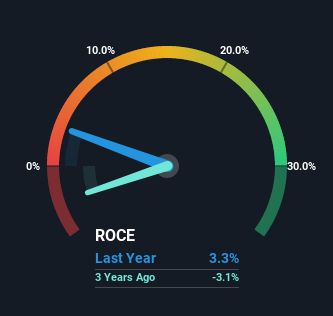If we want to find a potential multi-bagger, often there are underlying trends that can provide clues. One common approach is to try and find a company with returns on capital employed (ROCE) that are increasing, in conjunction with a growing amount of capital employed. Basically this means that a company has profitable initiatives that it can continue to reinvest in, which is a trait of a compounding machine. In light of that, when we looked at SunOpta (NASDAQ:STKL) and its ROCE trend, we weren't exactly thrilled.
Return On Capital Employed (ROCE): What Is It?
If you haven't worked with ROCE before, it measures the 'return' (pre-tax profit) a company generates from capital employed in its business. Analysts use this formula to calculate it for SunOpta:
Return on Capital Employed = Earnings Before Interest and Tax (EBIT) ÷ (Total Assets - Current Liabilities)
0.033 = US$23m ÷ (US$856m - US$161m) (Based on the trailing twelve months to December 2022).
Thus, SunOpta has an ROCE of 3.3%. In absolute terms, that's a low return and it also under-performs the Food industry average of 11%.
Check out our latest analysis for SunOpta

In the above chart we have measured SunOpta's prior ROCE against its prior performance, but the future is arguably more important. If you'd like to see what analysts are forecasting going forward, you should check out our free report for SunOpta.
What Can We Tell From SunOpta's ROCE Trend?
In terms of SunOpta's historical ROCE movements, the trend isn't fantastic. To be more specific, ROCE has fallen from 5.2% over the last five years. However, given capital employed and revenue have both increased it appears that the business is currently pursuing growth, at the consequence of short term returns. If these investments prove successful, this can bode very well for long term stock performance.
On a side note, SunOpta has done well to pay down its current liabilities to 19% of total assets. That could partly explain why the ROCE has dropped. Effectively this means their suppliers or short-term creditors are funding less of the business, which reduces some elements of risk. Some would claim this reduces the business' efficiency at generating ROCE since it is now funding more of the operations with its own money.
Our Take On SunOpta's ROCE
In summary, despite lower returns in the short term, we're encouraged to see that SunOpta is reinvesting for growth and has higher sales as a result. These trends are starting to be recognized by investors since the stock has delivered a 12% gain to shareholders who've held over the last five years. So this stock may still be an appealing investment opportunity, if other fundamentals prove to be sound.
If you'd like to know about the risks facing SunOpta, we've discovered 3 warning signs that you should be aware of.
For those who like to invest in solid companies, check out this free list of companies with solid balance sheets and high returns on equity.
New: Manage All Your Stock Portfolios in One Place
We've created the ultimate portfolio companion for stock investors, and it's free.
• Connect an unlimited number of Portfolios and see your total in one currency
• Be alerted to new Warning Signs or Risks via email or mobile
• Track the Fair Value of your stocks
Have feedback on this article? Concerned about the content? Get in touch with us directly. Alternatively, email editorial-team (at) simplywallst.com.
This article by Simply Wall St is general in nature. We provide commentary based on historical data and analyst forecasts only using an unbiased methodology and our articles are not intended to be financial advice. It does not constitute a recommendation to buy or sell any stock, and does not take account of your objectives, or your financial situation. We aim to bring you long-term focused analysis driven by fundamental data. Note that our analysis may not factor in the latest price-sensitive company announcements or qualitative material. Simply Wall St has no position in any stocks mentioned.
About NasdaqGS:STKL
SunOpta
Engages in the manufacture and sale of plant and fruit-based food and beverage products in the United States, Canada, and internationally.
Good value with moderate growth potential.
Similar Companies
Market Insights
Community Narratives



